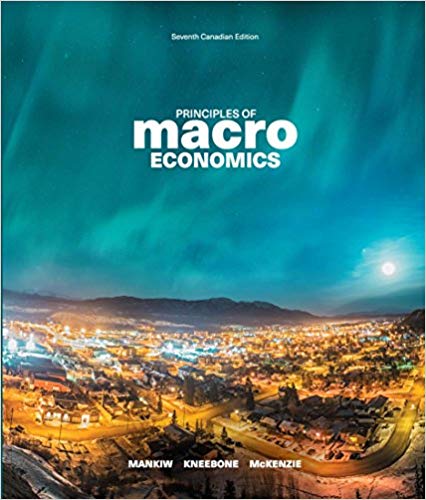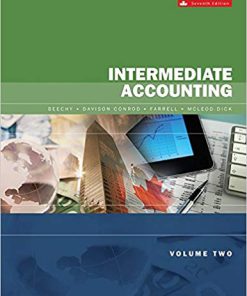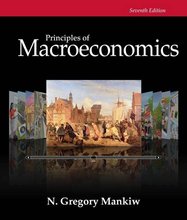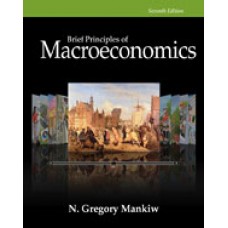Solution Manual for Principles of Macroeconomics, Seventh Canadian Edition
$35.00 Original price was: $35.00.$26.50Current price is: $26.50.
Solution Manual for Principles of Macroeconomics, Seventh Canadian Edition
Solution Manual for Principles of Macroeconomics, Seventh Canadian Edition digital download immediately after payment is complete.

Product details:
- ISBN-10 : 0176591990
- ISBN-13 : 978-0176591991
- Author: N. Gregory Mankiw
Principles of Macroeconomics, Seventh Canadian Edition, is designed to appeal to all students through its breakdown of concepts, focus on big ideas, and user-friendly language. As the market leader, its clear, concise, and consistent approach grounds students in difficult concepts and links theory to real-world applications, assisting in making the connection from page to action. Students receive a sophisticated understanding of how the economy operates without losing the big ideas through various pedagogical features that summarize major concepts, apply economic theory to students’ experiences and lives, and develop the building blocks required to achieve higher levels of understanding. As Mankiw states, “My goal in writing my text was to try and remember and to write a text that I would have liked to have read”, and this is the same approach he, Kneebone, and McKenzie have continued with the Seventh Canadian Edition.
Table contents:
- Chapter 1: Ten Principles of Economics
- 1-1: How People Make Decisions
- 1-1a: Principle #1: People Face Tradeoffs
- 1-1b: Principle #2: The Cost of Something Is What You Give Up to Get It
- 1-1c: Principle #3: Rational People Think at the Margin
- 1-1d: Principle #4: People Respond to Incentives
- 1-2: How People Interact
- 1-2a: Principle #5: Trade Can Make Everyone Better Off
- 1-2b: Principle #6: Markets Are Usually a Good Way to Organize Economic Activity
- 1-2c: Principle #7: Governments Can Sometimes Improve Market Outcomes
- 1-3: How the Economy as a Whole Works
- 1-3a: Principle #8: A Country’s Standard of Living Depends on Its Ability to Produce Goods and Ser
- 1-3b: Principle #9: Prices Rise When the Government Prints Too Much Money
- 1-3c: Principle #10: Society Faces a Short-Run Tradeoff between Inflation and Unemployment
- 1-4: Conclusion
- Summary
- Key Concepts
- Questions for Review
- Quick Check Multiple Choice
- Problems and Applications
- Chapter 2: Thinking Like an Economist
- 2-1: The Economist as Scientist
- 2-1a: The Scientific Method: Observation, Theory, and More Observation
- 2-1b: The Role of Assumptions
- 2-1c: Economic Models
- 2-1d: Our First Model: The Circular-Flow Diagram
- 2-1e: Our Second Model: The Production Possibilities Frontier
- 2-1f: Microeconomics and Macroeconomics
- 2-2: The Economist as Policy Adviser
- 2-2a: Positive versus Normative Analysis
- 2-2b: Economists in Ottawa
- 2-2c: Why Economists’ Advice Is Not Always Followed
- 2-3: Why Economists Disagree
- 2-3a: Differences in Scientific Judgments
- 2-3b: Differences in Values
- 2-3c: Perception versus Reality
- 2-4: Let’s Get Going
- Summary
- Key Concepts
- Questions for Review
- Quick Check Multiple Choice
- Problems and Applications
- Appendix: Graphing: A Brief Review
- Graphs of a Single Variable
- Graphs of Two Variables: The Coordinate System
- Curves in the Coordinate System
- Slope
- Graphing Functions
- Cause and Effect
- Chapter 3: Interdependence and the Gains from Trade
- 3-1: A Parable for the Modern Economy
- 3-1a: Production Possibilities
- 3-1b: Specialization and Trade
- 3-2: Comparative Advantage: The Driving Force of Specialization
- 3-2a: Absolute Advantage
- 3-2b: Opportunity Cost and Comparative Advantage
- 3-2c: Comparative Advantage and Trade
- 3-2d: The Price of Trade
- 3-3: Applications of Comparative Advantage
- 3-3a: Should Sidney Crosby Shovel His Own Sidewalk?
- 3-3b: Should Canada Trade with Other Countries?
- Conclusion
- Summary
- Key Concepts
- Questions for Review
- Quick Check Multiple Choice
- Problems and Applications
- Chapter 4: The Market Forces of Supply and Demand
- 4-1: Markets and Competition
- 4-1a: What Is a Market?
- 4-1b: What Is Competition?
- 4-2: Demand
- 4-2a: The Demand Curve: The Relationship between Price and Quantity Demanded
- 4-2b: Market Demand versus Individual Demand
- 4-2c: Shifts in the Demand Curve
- 4-3: Supply
- 4-3a: The Supply Curve: The Relationship between Price and Quantity Supplied
- 4-3b: Market Supply versus Individual Supply
- 4-3c: Shifts in the Supply Curve
- 4-4: Supply and Demand Together
- 4-4a: Equilibrium
- 4-4b: Three Steps to Analyzing Changes in Equilibrium
- 4-5: Conclusion: How Prices Allocate Resources
- Summary
- Key Concepts
- Questions for Review
- Quick Check Multiple Choice
- Problems and Applicaitons
- Chapter 5: Measuring a Nation’s Income
- 5-1: The Economy’s Income and Expenditure
- 5-2: The Measurement of Gross Domestic Product
- 5-2a: “GDP Is the Market Value …”
- 5-2b: “… Of All …”
- 5-2c: “… Final …”
- 5-2d: “… Goods and Services …”
- 5-2e: “… Produced …”
- 5-2f: “… Within a Country …”
- 5-2g: “… In a Given Period of Time”
- 5-3: The Components of GDP
- 5-3a: Consumption
- 5-3b: Investment
- 5-3c: Government Purchases
- 5-3d: Net Exports
- 5-4: Real versus Nominal GDP
- 5-4a: A Numerical Example
- 5-4b: The GDP Deflator
- 5-5: GDP and Economic Well-Being
- 5-6: Conclusion
- Summary
- Key Concepts
- Questions for Review
- Quick Check Multiple Choice
- Problems and Applications
- Chapter 6: Measuring the Cost of Living
- 6-1: The Consumer Price Index
- 6-1a: How the Consumer Price Index Is Calculated
- 6-1b: Problems in Measuring the Cost of Living
- 6-1c: The GDP Deflator versus the Consumer Price Index
- 6-2: Correcting Economic Variables for the Effects of Inflation
- 6-2a: Dollar Figures from Different Times
- 6-2b: Indexation
- 6-2c: Real and Nominal Interest Rates
- 6-3: Conclusion
- Summary
- Key Concepts
- Questions for Reivew
- Quick Check Multiple Choice
- Problems and Applications
- Chapter 7: Production and Growth
- 7-1: Economic Growth around the World
- 7-2: Productivity: Its Role and Determinants
- 7-2a: Why Productivity Is So Important
- 7-2b: How Productivity Is Determined
- 7-3: Economic Growth and Public Policy
- 7-3a: The Importance of Saving, Investment, and Stable Financial Markets
- 7-3b: Diminishing Returns and the Catch-Up Effect
- 7-3c: Investment from Abroad
- 7-3d: Education
- 7-3e: Health and Nutrition
- 7-3f: Property Rights and Political Stability
- 7-3g: Free Trade
- 7-3h: Research and Development
- 7-3i: Population Growth
- 7-4: Conclusion: The Importance of Long-Run Growth
- Summary
- Key Concepts
- Questions for Review
- Quick Check Multiple Choice
- Problems and Applications
- Chapter 8: Saving, Investment, and the Financial System
- 8-1: Financial Institutions in the Canadian Economy
- 8-1a: Financial Markets
- 8-1b: Financial Intermediaries
- 8-1c: Summing Up
- 8-2: Saving and Investment in the National Income Accounts
- 8-2a: Some Important Identities
- 8-2b: The Meaning of Saving and Investment
- 8-3: The Market for Loanable Funds
- 8-3a: Supply and Demand for Loanable Funds
- 8-3b: Policy 1: Saving Incentives
- 8-3c: Policy 2: Investment Incentives
- 8-3d: Policy 3: Government Budget Deficits and Surpluses
- Conclusion
- Summary
- Key Concepts
- Questions for Review
- Quick Check Multiple Choice
- Problems and Applicatoins
- Chapter 9: Unemployment and Its Natural Rate
- 9-1: Identifying Unemployment
- 9-1a: How Is Unemployment Measured?
- 9-1b: Does the Unemployment Rate Measure What We Want It To?
- 9-1c: How Long Are the Unemployed without Work?
- 9-1d: Why Are There Always Some People Unemployed?
- 9-2: Job Search
- 9-2a: Why Some Frictional Unemployment Is Inevitable
- 9-2b: Public Policy and Job Search
- 9-2c: Employment Insurance
- 9-3: Minimum-Wage Laws
- 9-4: Unions and Collective Bargaining
- 9-4a: The Economics of Unions
- 9-4b: Are Unions Good or Bad for the Economy?
- 9-5: The Theory of Efficiency Wages
- 9-5a: Worker Health
- 9-5b: Worker Turnover
- 9-5c: Worker Effort
- 9-6d: Worker Quality
- Conclusion
- Summary
- Key Concepts
- Questions for Reivew
- Quick Check Multiple Choice
- Problems and Applications
- Chapter 10: The Monetary System
- 10-1: The Meaning of Money
- 10-1a: The Functions of Money
- 10-1b: The Kinds of Money
- 10-1c: Money in the Canadian Economy
- 10-2: The Bank of Canada
- 10-2a: The Bank of Canada Act
- 10-2b: Monetary Policy
- 10-3: Commercial Banks and the Money Supply
- 10-3a: The Simple Case of 100 Percent-Reserve Banking
- 10-3b: Money Creation with Fractional-Reserve Banking
- 10-3c: The Money Multiplier
- 10-3d: Bank Capital, Leverage, and the Financial Crisis of 2007–09
- 10-3e: The Bank of Canada’s Tools of Monetary Control
- 10-3f: Problems in Controlling the Money Supply
- Conclusion
- Summary
- Key Concepts
- Questions for Review
- Quick Check Multiple Choice
- Problems and Applications
- Chapter 11: Money Growth and Inflation
- 11-1: The Classical Theory of Inflation
- 11-1a: The Level of Prices and the Value of Money
- 11-1b: Money Supply, Money Demand, and Monetary Equilibrium
- 11-1c: The Effects of a Monetary Injection
- 11-1d: A Brief Look at the Adjustment Process
- 11-1e: The Classical Dichotomy and Monetary Neutrality
- 11-1f: Velocity and the Quantity Equation
- 11-1g: The Inflation Tax
- 11-1h: The Fisher Effect
- 11-2: The Costs of Inflation
- 11-2a: A Fall in Purchasing Power? The Inflation Fallacy
- 11-2b: Shoeleather Costs
- 11-2c: Menu Costs
- 11-2d: Relative-Price Variability and the Misallocation of Resources
- 11-2e: Inflation-Induced Tax Distortions
- 11-2f: Confusion and Inconvenience
- 11-2g: A Special Cost of Unexpected Inflation: Arbitrary Redistributions of Wealth
- 11-2h: Inflation Is Bad, but Deflation May Be Worse
- 11-3: Conclusion
- Summary
- Key Concepts
- Questions for Reivew
- Quick Check Multiple Choice
- Problems and Applications
- Chapter 12: Open-Economy Macroeconomics: Basic Concepts
- 12-1: The International Flows of Goods and Capital
- 12-1a: The Flow of Goods: Exports, Imports, and Net Exports
- 12-1b: The Flow of Financial Resources: Net Capital Outflow
- 12-1c: The Equality of Net Exports and Net Capital Outflow
- 12-1d: Saving, Investment, and Their Relationship to the International Flows
- 12-1e: Summing Up
- 12-2: The Prices for International Transactions: Real and Nominal Exchange Rates
- 12-2a: Nominal Exchange Rates
- 12-2b: Real Exchange Rates
- 12-3: A First Theory of Exchange-Rate Determination: Purchasing-Power Parity
- 12-3a: The Basic Logic of Purchasing-Power Parity
- 12-3b: Implications of Purchasing-Power Parity
- 12-3c: Limitations of Purchasing-Power Parity
- 12-4: Interest Rate Determination in a Small Open Economy with Perfect Capital Mobility
- 12-4a: A Small Open Economy
- 12-4b: Perfect Capital Mobility
- 12-4c: Limitations to Interest Rate Parity
- 12-5: Conclusion
- Summary
- Key Concepts
- Questions for Review
- Quick Check Multiple Choice
- Problems and Applications
- Chapter 13: A Macroeconomic Theory of the Small Open Economy
- 13-1: Supply and Demand for Loanable Funds and for Foreign-Currency Exchange
- 13-1a: The Market for Loanable Funds
- 13-1b: The Market for Foreign-Currency Exchange
- 13-1c: Disentangling Supply and Demand in the Market for Foreign-Currency Exchange
- 13-2: Equilibrium in the Small Open Economy
- 13-2a: Net Capital Outflow: The Link between the Two Markets
- 13-2b: Simultaneous Equilibrium in Two Markets
- 13-3: How Policies and Events Affect a Small Open Economy
- 13-3a: Increase in World Interest Rates
- 13-3b: Government Budget Deficits and Surpluses
- 13-3c: Trade Policy
- 13-3d: Political Instability and Capital Flight
- 13-4: Conclusion
- Summary
- Key Concepts
- Questions for Review
- Quick Check Multiple Choice
- Problems and Applications
- Chapter 14: Aggregate Demand and Aggregate Supply
- 14-1: Three Key Facts about Economic Fluctuations
- 14-1a: Fact 1: Economic Fluctuations Are Irregular and Unpredictable
- 14-1b: Fact 2: Most Macroeconomic Quantities Fluctuate Together
- 14-1c: Fact 3: As Output Falls, Unemployment Rises
- 14-2: Explaining Short-Run Economic Fluctuations
- 14-2a: The Assumptions of Classical Economics
- 14-2b: The Reality of Short-Run Fluctuations
- 14-2c: The Model of Aggregate Demand and Aggregate Supply
- 14-3: The Aggregate-Demand Curve
- 14-3a: Why the Aggregate-Demand Curve Slopes Downward
- 14-3b: Why the Aggregate-Demand Curve Might Shift
- 14-4: The Aggregate-Supply Curve
- 14-4a: Why the Aggregate-Supply Curve Is Vertical in the Long Run
- 14-4b: Why the Long-Run Aggregate-Supply Curve Might Shift
- 14-4c: Using Aggregate Demand and Aggregate Supply to Depict Long-Run Growth and Inflation
- 14-4d: Why the Aggregate-Supply Curve Slopes Upward in the Short Run
- 14-4e: Why the Short-Run Aggregate-Supply Curve Might Shift
- 14-5: Two Causes of Economic Fluctuations
- 14-5a: Effects of a Shift in Aggregate Demand
- 14-5b: The Effects of a Shift in Aggregate Supply
- 14-6: Conclusion
- Summary
- Key Concepts
- Questions for Review
- Quick Check Multiple Choice
- Problems and Applications
- Chapter 15: The Influence of Monetary and Fiscal Policy on Aggregate Demand
- 15-1: How Monetary Policy Influences Aggregate Demand
- 15-1a: The Theory of Liquidity Preference
- 15-1b: The Downward Slope of the Aggregate-Demand Curve
- 15-1c: Changes in the Money Supply
- 15-1d: Open-Economy Considerations
- 15-2: How Fiscal Policy Influences Aggregate Demand
- 15-2a: Changes in Government Purchases
- 15-2b: The Multiplier Effect
- 15-2c: A Formula for the Spending Multiplier
- 15-2d: Other Applications of the Multiplier Effect
- 15-2e: The Crowding-Out Effect on Investment
- 15-2f: Open-Economy Considerations
- 15-2g: Changes in Taxes
- 15-2h: Deficit Reduction
- 15-3: Using Policy to Stabilize the Economy
- 15-3a: The Case for Active Stabilization Policy
- 15-3b: The Case against Active Stabilization Policy
- 15-3c: Automatic Stabilizers
- 15-3d: A Flexible Exchange Rate as an Automatic Stabilizer
- 15-4: A Quick Summary
- 15-5: Conclusion
- Summary
- Key Concepts
- Questions for Review
- Quick Check Multiple Choice
- Problems and Applications
- Chapter 16: The Short-Run Tradeoff between Inflation and Unemployment
- 16-1: The Phillips Curve
- 16-1a: Origins of the Phillips Curve
- 16-1b: Aggregate Demand, Aggregate Supply, and the Phillips Curve
- 16-2: Shifts in the Phillips Curve: The Role of Expectations
- 16-2a: The Long-Run Phillips Curve
- 16-2b: The Meaning of “Natural”
- 16-2c: Reconciling Theory and Evidence
- 16-2d: The Short-Run Phillips Curve
- 16-2e: The Natural Experiment for the Natural-Rate Hypothesis
- 16-3: Shifts in the Phillips Curve: The Role of Supply Shocks
- 16-4: The Cost of Reducing Inflation
- 16-4a: The Sacrifice Ratio
- 16-4b: Rational Expectations and the Possibility of Costless Disinflation
- 16-4c: Disinflation in the 1980s
- 16-4d: The Zero-Inflation Target
- 16-4e: Anchored Expectations
- 16-4f: The 2008–09 Recession
- 16-5: Looking Ahead
- 16-6: Conclusion
- Summary
- Key Concepts
- Questions for Review
- Quick Check Multiple Choice
- Problems and Applications
- Chapter 17: Five Debates over Macroeconomic Policy
- 17-1: Should Monetary and Fiscal Policymakers Try to Stabilize the Economy?
- 17-1a: Pro: Policymakers Should Try to Stabilize the Economy
- 17-1b: Con: Policymakers Should Not Try to Stabilize the Economy
- 17-2: Should Monetary Policy Be Made by an Independent Central Bank?
- 17-2a: Pro: Monetary Policy Should Be Made by an Independent Central Bank
- 17-2b: Con: Monetary Policy Should Not Be Made by an Independent Central Bank
- 17-3: Should the Central Bank Aim for Zero Inflation?
- 17-3a: Pro: The Central Bank Should Aim for Zero Inflation
- 17-3b: Con: The Central Bank Should Not Aim for Zero Inflation
- 17-4: Should Governments Balance Their Budgets?
- 17-4a: Pro: Governments Should Balance Their Budgets
- 17-4b: Con: Governments Should Not Balance Their Budgets
- 17-5: Should the Tax Laws Be Reformed to Encourage Saving?
- 17-5a: Pro: The Tax Laws Should Be Reformed to Encourage Saving
- 17-5b: Con: The Tax Laws Should Not Be Reformed to Encourage Saving
- 17-6: Conclusion
- Summary
- Questions for Review
- Quick Check Multiple Choice
- Problems and Applicaitons
People also search:
principles of macroeconomics seventh edition
principles of macroeconomics 7th edition
7 principles of economics explained
what are the 10 principles of macroeconomics
7 economic principles examples
principles of macroeconomics 7th edition answer key
seven principles of microeconomics
You may also like…
Solution Manual
Solution Manual for Brief Principles of Macroeconomics, 7th Edition N. Gregory Mankiw
Solution Manual
Principles of Macroeconomics Mankiw 7th Edition Solutions Manual
Solution Manual
Principles of Macroeconomics 8th Edition Mankiw Solutions Manual












